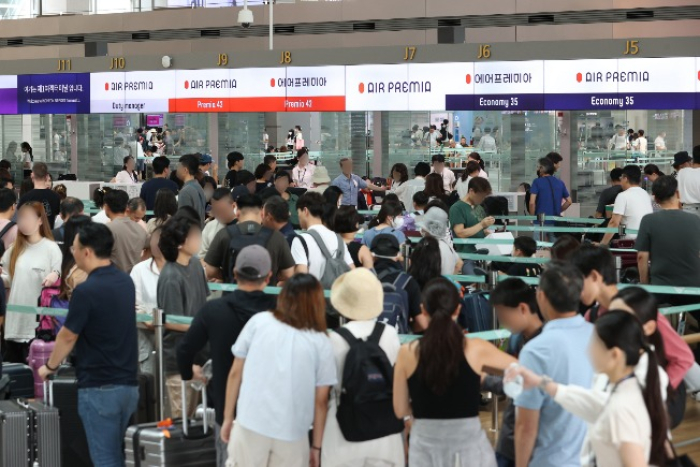South Korea's most popular international flight route in the first half of this year was between Incheon International Airport and Kansai International Airport in Osaka, Japan.
Incheon-Hong Kong, the most popular route in the first half of 2019 before the COVID-19 pandemic hit, fell out of South Korea's top 10 list of travel destinations.
The Ministry of Land, Infrastructure and Transport on Monday released flight statistics saying the number of passengers on the Incheon-Osaka route from January to June was 1,709,000, topping all international routes departing from domestic airports.
Second was Tokyo (Narita) with 1,637,000 and third Bangkok with 1,410,000, followed in order by Fukuoka, Japan, with 1,286,000, Singapore 973,000, Danang, Vietnam 944,000, Taipei, Taiwan, 915,000, Ho Chi Minh City, Vietnam, 806,000 and Manila, the Philippines 771,000.
No. 10 was the route linking Gimpo International Airport in Seoul with Tokyo (Haneda) International Airport with 769,000.
Four of the top 10 routes in the number of passengers in the year's first half were to Japan and five to Southeast Asian states like Vietnam, Thailand and the Philippines.
The rankings were in stark contrast to those four years ago. In the first half of 2019, routes to Greater China, which covers China, Hong Kong, Macao and Taiwan, where the majority of the population are culturally and ethnically Han Chinese, occupied three of the top 10 routes: Hong Kong first, Taipei seventh and Shanghai, China, ninth. Over the same period this year, however, only Taipei remained in the top 10, with China absent.
The Incheon-Hong Kong route, which ranked first in the first half of 2019 with 1,717,000 passengers, fell to 11th with 712,000 year on year. The number on the Incheon-Shanghai (Pudong) route, which was ninth four years ago, fell to 221,000, around a fifth of 1,006,000 in the first half of 2019.
Thus more travelers in South Korea looked to Japan and Southeast Asia, with certain routes to and from both regions seeing more passenger traffic than before the pandemic.
This year, the Incheon-Osaka route had 1,709,000 passengers, 40,000 more than in the first half of 2019, Incheon-Tokyo (Narita) 1,637,000, up 180,000, and Incheon- Bangkok 1,410,000 million, up 65,000.
The main factor in the changed rankings is Southeast Asia and Japan lifting entry restrictions faster than China to attract tourists.
Vietnam in May last year lifted the requirement for COVID-19 inspections on arrivals. Thailand, whose main industry is tourism, lifted most of its restrictions from July last year.
Japan also abolished most limits on arrivals in October last year to allow individual travel without a visa.
China has gradually eased regulations on overseas travel since early this year, but its passenger growth remains slow due to a complicated visa issuance process and lack of recovery in domestic travel sentiment.
"Japan and Southeast Asian countries lifted quarantine measures earlier than Greater China, and thus the surge in supply led by low-cost carriers for routes to and from Japan apparently affected changes in passenger trends," an industry source said.
Write to Mi-Sun Kang at
misunny@hankyung.com




